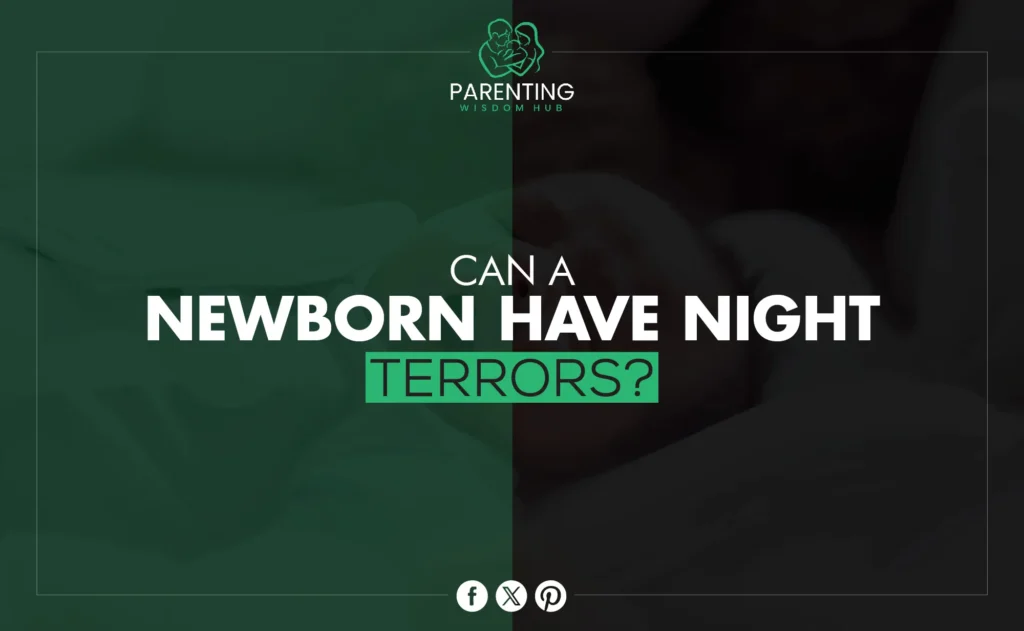Introduction
As a new parent, you might wonder if your baby can have night terrors. Night terrors in infants are rare, but knowing about newborn sleep issues is key. Newborns sleep a lot, and understanding their sleep patterns is important. This section will help you understand if newborns can have night terrors, helping you ensure peaceful nights for your family.
Key Takeaways
- Night terrors are mainly seen in older kids, but knowing about them in newborns is important.
- Night terrors happen during deep sleep, which newborns often experience.
- Knowing about infant sleep patterns can help manage sleep issues.
- Not all sleep problems in babies are night terrors; some are less serious.
- Spotting the signs of sleep issues early can help you act quickly.
Night Terrors in Children
Children’s night terrors are acute fears that impair sleep. Screaming and thrashing occur during non-REM sleep. Watching your youngster panic and look ignorant is terrifying.
2- to 6-year-olds often have night terrors. These episodes may cause bewilderment, a rapid heart rate, and perspiration in youngsters. Parental and kid anguish is severe. Parents should know these signs because they may confuse night terrors with other sleep issues.
Seeing the signals early helps handle these terrifying periods. Understanding night terrors may reassure. Watching carefully distinguishes night terrors from other sleep disorders. Understanding children’s sleep issues begins here.
The Sleep Patterns of Newborns
Many newborns sleep 14–17 hours a day. Their sleep is fragmented. Parents must grasp these patterns to suit their baby’s requirements.
Newborns alternate REM and non-REM sleep. They spend much of their time in REM, which helps brain development. This stage is critical for early learning and growth.
Your infant will sleep differently as they grow. Longer, more frequent sleep. These alterations indicate brain development.
| Age Range | Total Sleep (Hours) | Average Sleep Cycle Length | Typical Sleep Pattern |
|---|---|---|---|
| 0-2 months | 14-17 | 50-60 minutes | Frequent short bursts |
| 2-4 months | 12-15 | 60-90 minutes | The increased duration between sleep |
| 4-6 months | 12-14 | 90-120 minutes | Longer periods of sleep at night |
Knowing how newborns sleep helps parents create a cozy sleep space for them.
What Are Night Terrors?
Kids are most affected by night terrors. A youngster may seem awake with wide-open eyes during an episode but is still asleep. Combined look and sleep condition make it stand out.
Early NREM sleep is when these events occur. Kids express fear, bewilderment, and loud wailing, which may scare parents. Kids don’t recall night terrors, unlike nightmares.
Many things may induce night terrors. Sleep disorder genetics are important. Sleep deprivation also causes them, emphasizing the necessity of sleep.
To better understand the differences, here’s a table comparing night terrors and other sleep issues:
| Feature | Night Terrors | Childhood Nightmares |
|---|---|---|
| Sleep Stage | NREM sleep | REM sleep |
| Awareness | Limited awareness; appears awake | Fully aware upon waking |
| Memory | No recollection of the episode | Can recall details of the nightmare |
| Duration | Typically lasts 5-20 minutes | Duration varies; may last longer |
| Parental Response | May require calming; often confused | Consolation is needed; the child may talk about it |
Knowing the differences between night terrors and nightmares is key for parents. It helps them better support their kids during these episodes.
Can a Newborn Have Night Terrors?
Many parents wonder if newborns can have night terrors. Night terrors usually start after kids are two years old. But newborns can still have other sleep problems. It’s important to know about these issues to understand their sleep development.
Defining Ages and Stages of Sleep Disorders
Infant sleep problems vary from adult children’s. In the first several months, babies’ sleep fluctuates drastically. They may have problems falling asleep or inconsistent sleep habits.
Your child’s sleep phases fluctuate with age. These alterations indicate whether their sleep is normal or abnormal. Newborns struggle with sleep cycles, not night terrors.
The Developmental Timeline of Night Terrors
Growing kids modify sleep disorder timelines. Night terrors begin after birth and toddlerhood. By two years old, children are more prone to having night terrors because their brains are more active when sleeping.
Tracking your child’s sleep helps identify issues. Knowing when night terrors start helps you assist your kid sleep.
Signs and Symptoms of Night Terrors
It can be hard to tell if your child is having a night terror or just a bad dream. Night terrors happen when your child is very deep in sleep. They can show signs like:
- Screaming or crying often without a clear reason
- Rapid heart rate and sweating
- Inability to communicate rationally during the episode
- Confusion or disorientation upon waking
- Restlessness and frequent movement within the sleep environment
Knowing your child’s sleep symptoms is crucial. They distinguish dreams from night terrors. Parents sometimes dismiss these occurrences as unpleasant nightmares, unaware of their importance.
Make your child’s bedroom pleasant and keep calm throughout an incident. Keeping a sleep journal might help you detect night terror tendencies. Being with your kid after an event might help them feel secure. Early detection of these signs may help your kid sleep.
| Sign/Symptom | Description |
|---|---|
| Screaming or Crying | Sudden, loud outbursts that often occur during sleep indicate distress. |
| Physical Symptoms | Includes rapid heart rate and increased sweating, showing a physiological response. |
| Communication | Difficulty in coherent communication during an episode, leading to confusion. |
| Post-Episode Behavior | Disorientation or confusion immediately after waking, often lasting several minutes. |
| Restlessness | Frequent movements in bed that may seem erratic and unintentional. |
Differences Between Nightmares and Night Terrors
For kids, it’s important to know the difference between dreams and night terrors. They both can be scary, but they happen at different times while you sleep. The more you know about these differences, the better you can help your child sleep.
Characteristics of Nightmares
When a kid is in REM sleep, they have nightmares. These dreams are very real and can scare or worry the child. When they wake up, they often remember the dream. Some signs of dreams are:
- Waking up in a state of distress
- Recounting the dream with clarity
- Difficulty returning to sleep due to fear
Knowing these signs can help you find the right support for your child.
How Night Terrors Manifest
Night terrors happen in non-REM sleep, and the child usually doesn’t remember them in the morning. Signs of night terrors include:
- Screaming or crying during sleep
- Rapid heart rate and sweating
- Unresponsive behavior when comforted
Understanding night terrors helps you manage them better. It’s key to tell nightmares apart from night terrors to care for your child’s sleep.
| Aspect | Nightmares | Night Terrors |
|---|---|---|
| Sleep Stage | Occurs during REM sleep | Occurs during non-REM sleep |
| Memory | Typically remembered | Usually not remembered |
| Intensity | High levels of anxiety and fear | Extreme distress, but the child appears tranquil afterward |
| Parental Intervention | A child can be soothed | A child may resist comfort |
Causes of Night Terrors in Children
Understanding child night terrors requires several components. Big genetic tendency. Your youngster may develop night terrors if family members do.
Sleep deprivation also matters. Night terrors are more common in children who don’t get enough sleep. Regular sleep reduces this danger.
Even external stimuli may cause night terrors. Starting school or family changes might produce these outbursts. These periods may increase night terrors in your kid.
Medical problems may contribute. Restless leg syndrome or sleep apnea may cause night terrors. These factors must be addressed to help your kid sleep.
Watching your child’s sleep surroundings might reveal their tendencies. Understanding and regulating triggers may enhance sleep.
What to Do If Your Child Experiences Night Terrors
Dealing with night terrors can be tough for both you and your child. Knowing what to do right away and long-term can really help. Certain strategies can help you support your child through these episodes and improve their sleep.
Immediate Steps to Take
When your child has a night terror, it’s key to act quickly to reduce their distress. Here are some steps you can take:
- Make sure the sleeping area is safe by removing any dangers.
- Help your child back to sleep without waking them, as they might be confused.
- Speak softly to them, reassuring them you’re there.
Long-Term Strategies for Management
A plan is needed for long-term sleep issues. These strategies can help reduce night terrors:
- Start a bedtime routine that helps your child relax and get ready for sleep.
- Find and fix any outside stressors, like changes in the home or routine that might cause night terrors.
- Talk openly about sleep, letting your child share any fears or worries.
- If night terrors keep happening, talk to a pediatrician for more advice and strategies.
You can better manage night terrors by taking these immediate steps and long-term actions. This will help your child sleep more peacefully.
When to Seek Professional Help
You may not know when your kid needs a sleep aid. More frequent or severe night terrors need treatment. If these incidents persist in keeping your kid up and stressing them out, act.
Look for indicators like daytime sleepiness in your youngster. Watch for mood swings and difficulty with daily duties. These symptoms may indicate a sleep issue. Talking to a pediatric sleep expert may assist.
They may recommend sleep changes or health checks. Early intervention may improve your child’s sleep and mood.
Expert Opinions on Infant Sleep Issues
Parents with sleep issues must understand newborn sleep. Pediatric sleep specialists discuss neonatal and early child sleep concerns. Early childhood sleep problems are said to occur.
Pediatric sleep experts say an infant’s health depends on a suitable sleep environment. They suggest parents maintain sleep habits to help youngsters sleep. As the first year is for developing appropriate sleep patterns, experts advise parents to observe attentively.
Experts believe that baby sleep knowledge is powerful. Current research helps parents make good sleep decisions for their children. Understanding sleep issues is essential to improving them.
| Key Insights | Descriptions |
|---|---|
| Critical Period of Sleep Development | The first year of life is crucial for establishing sleep patterns. |
| Importance of a Consistent Routine | A predictable bedtime routine can promote better sleep quality. |
| Professionally Recommended Practices | Pediatric specialists advocate for safe sleep environments to reduce risks associated with sleep disorders. |
| Role of Parental Knowledge | Staying informed about sleep research helps parents navigate sleep challenges effectively. |
Conclusion
Helping your baby sleep requires understanding infant sleep difficulties. Night terrors are infrequent, but warning indications are crucial. The importance of monitoring infant sleep space and behaviors has been explored in this article.
Keep an eye out for night terrors and help your youngster. A relaxing nighttime ritual and monitoring sleep patterns may assist. Understanding baby sleep helps you solve sleep issues.
If your child’s sleep keeps you awake, seek assistance. Early expert consultation may make a great impact. It improves sleep and reduces sleep anxieties for you and your kid.


